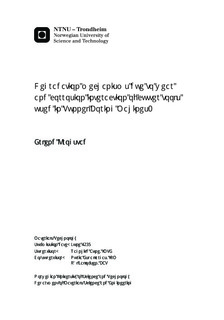Degradation mechanisms due to wear and corrosion interaction of cutter tools used in Tunnel Boring Mahines.
Master thesis
Permanent lenke
http://hdl.handle.net/11250/249336Utgivelsesdato
2013Metadata
Vis full innførselSamlinger
Sammendrag
A better understanding of the wear and corrosion mechanisms at work on the steel cutters during tunnel boring is needed to further improve the use of tunnel boring machines in tunnel excavation.In this master thesis several experiments were conducted to determine the wear and corrosion properties of a steel designed for tunnel boring machines. In tunnel boring it is common to use lubrication to decrease the wear of the steel. Therefore, to test the corrosiveness of the lubricants, several polarization curves were measured for the steel at different conditions. The tests were performed for the three lubricants that was used in this master thesis: ABR5, SLF41, and SLF47B. And the electrolyte used during the polarization tests were: 3% lubricant, 3% lubricant with 1.4% NaCl and 3% lubricant with 3.4% NaCl. To test the wear and how wear and corrosion affected the steel, reciprocal ball-on-plate tests were performed during several different conditions. The steel was rubbed against a rock surface of Iddefjords Granite in dry conditions, distilled water, and in 3% of three different types of foam additives (polymer lubricant). The lubricants were supplied and produced by BASF and were ABR5, SLF41 and SLF47B. All of the tests were also conducted in 1.4% and 3.4% NaCl-solution. For repeatability purposes all the tests were performed twice. The dry test showed severe wear on both the steel and the rock surface. The adding of water caused little difference in friction but it did reduce the wear. By adding foam the friction and wear significantly decreased, however, it caused some corrosion on the steel. SLF41 was the least effective foam with regards of wear, suggesting that it did not achieve elastohydrodynamic lubrication and it also generated relatively large amounts of corrosion on the steel. ABR5 and SLF47B were the most efficient reducing wear. In 1.4% NaCl solution SLF41 and SLF47B performed poorer than it did without NaCl and at 3.4% NaCl. However, the poor result of SLF47B with 1.4% NaCl is believed to be caused by failure during testing. At 3.4% NaCl the tribocorrosional behavior of all the foams was poorer than without the presence of NaCl. However, using SLF47B led to less corrosion than the other foams, maybe suggesting some type of corrosion inhibitors might be present. The tests showed that the foams clearly have a positive effect with regards to wear, but some had corrosive effects on the steel. It will be important to consider the environment were the tunnel excavation is done to ensure that the correct foam that yields the lowest wears and corrosion possible is chosen.
